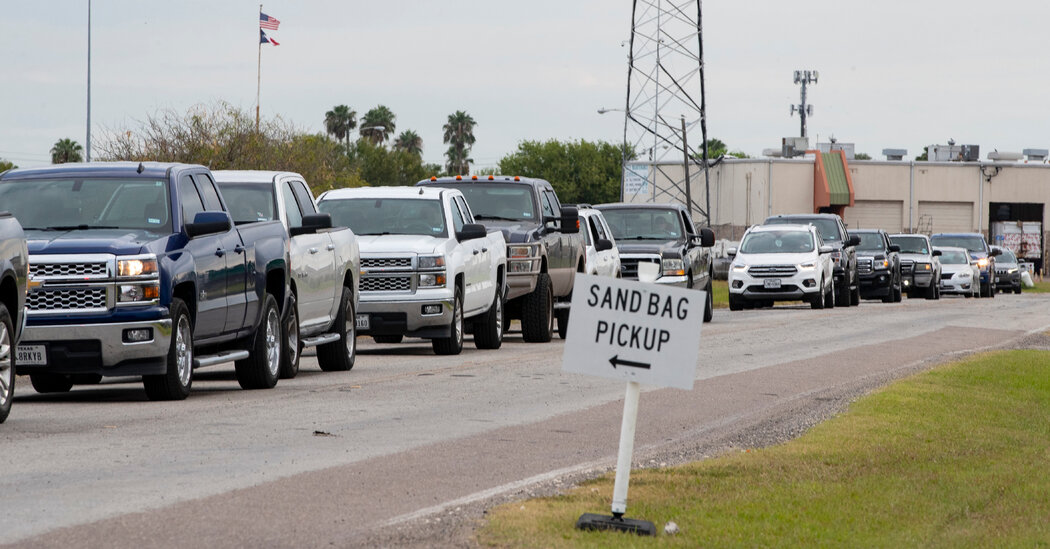A hurricane bearing down on southern Texas on Saturday morning is expected to bring harsh winds and rain to Corpus Christi and the surrounding area, where officials are already struggling to contain the coronavirus pandemic.
Powerful winds from Hurricane Hanna, which strengthened from a tropical storm to a Category 1 hurricane on Saturday morning, are expected to thrash Texas’s coast . The National Weather Service warned of possible power outages, damage to porches and sheds, and winds that could snap large tree limbs.
“We’re also really concerned about hurricane-force gusts, which would mean winds of greater than 74 miles per hour,” said Melissa Huffman, a meteorologist at the National Weather Service office in Corpus Christi.
The National Hurricane Center issued a hurricane warning for over more than 100-mile region on the coast, from Port Mansfield to Mesquite Bay. A storm surge warning reached even farther north, to about 75 miles south of Houston.
The hurricane, the first of the Atlantic season, was churning about 100 miles off the coast of Corpus Christi on Saturday morning, with its winds reaching 75 m.p.h. It is moving west at about nine miles per hour, and the center of the hurricane is expected to make landfall on Saturday afternoon or evening, the hurricane center said, but coastal residents will begin to feel powerful winds before then.
The storm’s trajectory turned south overnight, and its eye is no longer predicted to pass directly over Corpus Christi, but strong winds and rain were expected slam into the city of more than 300,000 people.
And forecasters say Hurricane Hanna’s dangers are many.
In addition to the wind, forecasters with the hurricane center said the storm would bring up to a foot of rain, with some isolated areas getting up to 18 inches over the weekend, which could lead to “life-threatening flash flooding.” They also said tornadoes are possible on Saturday and overnight into Sunday over parts of the coast.
The new threat comes as coronavirus cases have been rising in several counties in the storm’s path. In Nueces County, which includes Corpus Christi and is home to about 362,000 people, the number of virus cases and deaths reported each day has trended upward in recent weeks, fueled in part by visitors who flocked to the beach city because of its low case count.
About 10,000 people in the county have been infected with the virus; more than a fifth of those cases were reported in the past week. At least 124 people have died in Nueces County, and 421 people were being treated for the coronavirus in hospitals on Thursday, the highest total since the pandemic began.
“What a combination of events that we’ve had in South Texas,” Robert Rocha, the fire chief in Corpus Christi, said on Friday evening. “Corpus Christi in the last month has really been devastated by the effects of Covid-19. On top of that, we have the potential of a hurricane coming our way.”
The Coronavirus Outbreak ›
Frequently Asked Questions
Updated July 23, 2020
-
What is school going to look like in September?
- It is unlikely that many schools will return to a normal schedule this fall, requiring the grind of online learning, makeshift child care and stunted workdays to continue. California’s two largest public school districts — Los Angeles and San Diego — said on July 13, that instruction will be remote-only in the fall, citing concerns that surging coronavirus infections in their areas pose too dire a risk for students and teachers. Together, the two districts enroll some 825,000 students. They are the largest in the country so far to abandon plans for even a partial physical return to classrooms when they reopen in August. For other districts, the solution won’t be an all-or-nothing approach. Many systems, including the nation’s largest, New York City, are devising hybrid plans that involve spending some days in classrooms and other days online. There’s no national policy on this yet, so check with your municipal school system regularly to see what is happening in your community.
-
Is the coronavirus airborne?
- The coronavirus can stay aloft for hours in tiny droplets in stagnant air, infecting people as they inhale, mounting scientific evidence suggests. This risk is highest in crowded indoor spaces with poor ventilation, and may help explain super-spreading events reported in meatpacking plants, churches and restaurants. It’s unclear how often the virus is spread via these tiny droplets, or aerosols, compared with larger droplets that are expelled when a sick person coughs or sneezes, or transmitted through contact with contaminated surfaces, said Linsey Marr, an aerosol expert at Virginia Tech. Aerosols are released even when a person without symptoms exhales, talks or sings, according to Dr. Marr and more than 200 other experts, who have outlined the evidence in an open letter to the World Health Organization.
-
What are the symptoms of coronavirus?
- Common symptoms include fever, a dry cough, fatigue and difficulty breathing or shortness of breath. Some of these symptoms overlap with those of the flu, making detection difficult, but runny noses and stuffy sinuses are less common. The C.D.C. has also added chills, muscle pain, sore throat, headache and a new loss of the sense of taste or smell as symptoms to look out for. Most people fall ill five to seven days after exposure, but symptoms may appear in as few as two days or as many as 14 days.
-
What’s the best material for a mask?
- Scientists around the country have tried to identify everyday materials that do a good job of filtering microscopic particles. In recent tests, HEPA furnace filters scored high, as did vacuum cleaner bags, fabric similar to flannel pajamas and those of 600-count pillowcases. Other materials tested included layered coffee filters and scarves and bandannas. These scored lower, but still captured a small percentage of particles.
-
Does asymptomatic transmission of Covid-19 happen?
- So far, the evidence seems to show it does. A widely cited paper published in April suggests that people are most infectious about two days before the onset of coronavirus symptoms and estimated that 44 percent of new infections were a result of transmission from people who were not yet showing symptoms. Recently, a top expert at the World Health Organization stated that transmission of the coronavirus by people who did not have symptoms was “very rare,” but she later walked back that statement.
Chief Rocha said his crews were boarding up some coastal fire stations and preparing for the possibility of having to evacuate some of the more exposed stations, moving firefighters inland.
Hanna is the eighth named storm of the Atlantic hurricane season, which runs from June 1 to Nov. 30.
Meanwhile, in the Pacific Ocean, a Category 3 hurricane continued to churn toward Hawaii, although forecasters said the hurricane, named Douglas, was likely to weaken significantly as it got closer to the islands.
Hurricane Douglas is expected to be at or near hurricane strength when it nears the eastern end of the Hawaiian islands by Saturday night or Sunday, a spokesman for the National Hurricane Center said on Friday.
A tropical storm, named Gonzalo, is moving toward the Windward Islands in the Caribbean. It is unlikely to reach hurricane strength, forecasters said.
Derrick Bryson Taylor and Marie Fazio contributed reporting.


















